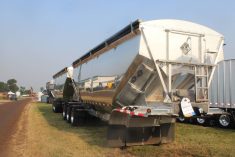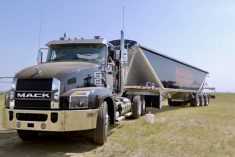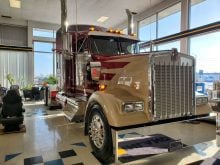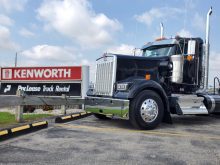All of the news in the automotive industry these days seems to revolve around electric drivetrain development, even in heavy trucks. But it’s clear when it comes to heavy equipment and trucks, diesel engines will still be with us for years to come. Equipment and heavy truck manufacturers are still working toward making internal combustion engines even better when it comes to emissions and fuel efficiency.
Navistar’s International Trucks brand is the latest to roll out a co-ordinated diesel-powered drivetrain for the 21st century — the S13 integrated powertrain, which is a 13-litre diesel with a dual-stage emissions system paired with a new, 14-speed automated manual transmission.
“The path toward a zero-emissions future requires improvements to traditional propulsion technologies parallel to the development of new powertrain technologies,” said Michael Grahe, executive vice-president of operations at Navistar. “To ensure optimal reliability, efficiency, performance and sustainability, we designed the S13 integrated powertrain from the ground up.”
Read Also

Claas brings 1000 Series SP forage harvesters to Canada
In mid-August, Claas unveiled its new line of Jaguar forage harvesters at an event in Visalia, California, deep in the heart of that state’s dairy region.
Navistar claims the “clean sheet” engineering approach significantly increases operating efficiency, reliability and durability with a simpler design that includes a fixed-geometry turbo, rather than the more complex variable-geometry types a lot of engine manufacturers have turned to. And it relies on a low r.p.m., high torque operating range, something we’ve seen other manufacturers introduce in their engines like AGCO’s Fendt brand.
The S13 powertrain develops peak torque at just 900 r.p.m., and is available in seven engine rating options, topping out at 515 horsepower and 1,850 pound-feet of torque at 2,000 r.p.m. governed speed.
More power, improved performance
To keep the exhaust clean, the S13 gets selective catalytic reduction. It has no exhaust gas recirculation (EGR) cooler and flows 100 per cent of the exhaust to the turbocharger in normal engine operating conditions. That eliminates the recirculation of exhaust gas and ensures a more complete fuel burn, which allows cleaner air to enter the combustion chamber on the intake cycle to mitigate soot buildup. This, says Navistar, adds up to more power and improved engine performance.
Low-friction materials and finishes are used for the liners, rings and bearings. The engine design eliminated the downstream fuel injector, and the high-pressure fuel pump operates at a lower pressure of 1,800 bar (about 26,000 psi). Up top is a dual overhead cam and cast aluminum cam cover, as well as an aluminum oil pan down below. That helps the S13 powertrain weigh in as one of the lightest on the market.
Bolted behind the new S13 diesel is the first commercial transmission ever offered by International, the T14. It’s a 14-speed, fully automated manual transmission with an electronic clutch actuator for faster, smoother shifting. It uses logic and integrated software controls for gear shifting perfectly matched to engine revolutions, says Navistar.
The transmission has two crawler gears for improved heavy load startup and low-speed manoeuvring. It also offers a direct drive in an overdrive package. It has shift-on-the-fly capabilities with economy, performance and performance-plus modes. The T14 also has hill hold and initial vehicle movement modes.
The dual-stage aftertreatment has easy access for serviceability, as well as significantly improved emissions control and better fuel efficiency.
Since an EGR cooler was eliminated from the combustion process, less soot and particulate matter are generated. This cleaner combustion cycle allows for extended service intervals and eliminates the need for an active regeneration cycle and the diesel oxidation catalyst.
“To ensure superior performance and reliability of the S13 integrated powertrain, it has been designed to meet the toughest requirements of the North American market,” said Grahe. “Before this integrated powertrain goes into serial production, this product will have logged more than four million miles of field testing on North American roads. We are testing on all terrains — from the desert of Arizona to the frozen tundra of Alaska.”
















